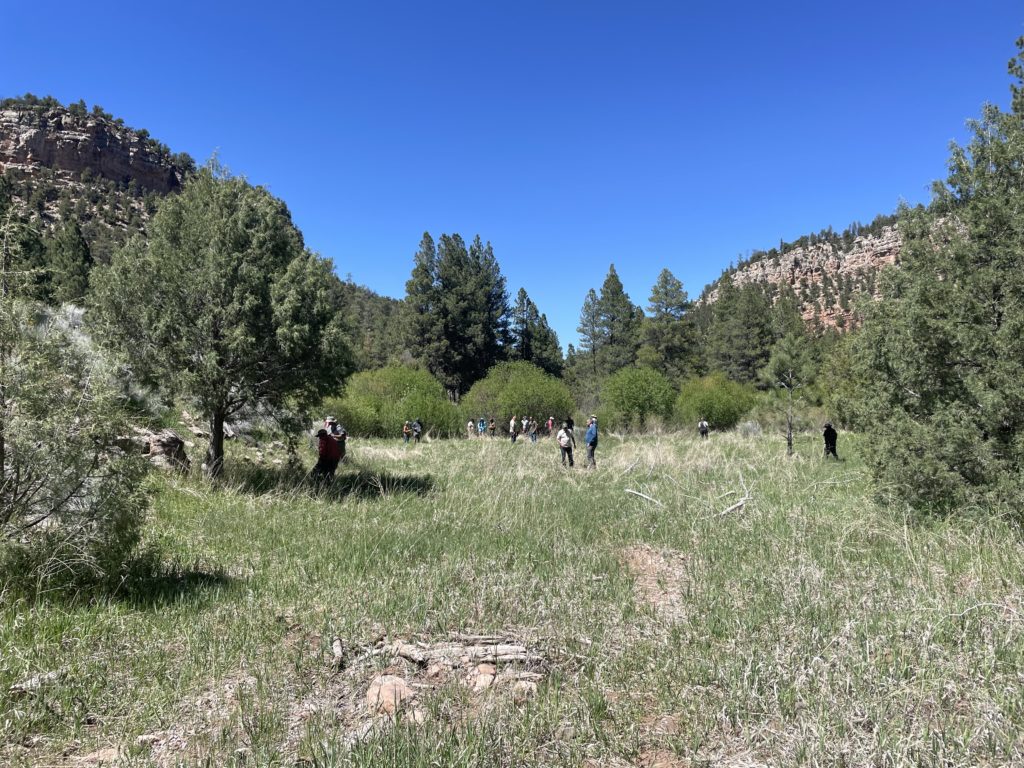A Look into the Collaborative Efforts in the Zuni Mountains
 Written by Daisy Smith
Written by Daisy Smith
On June 5th, 2024, I attended the Zuni Mountains Collaborative – Annual Field Tour in west-central New Mexico. As a new intern at the Forest Stewards Guild, this was a fantastic way for me to better understand and observe some of the Guild’s important collaborative natural resource work.
The Zuni Mountains Collaborative (ZMC) started with informal partnerships between the Cibola National Forest, The Forest Stewards Guild, and multiple other stakeholders. As the partnerships grew and formalized over time, a structured collaborative was created to better steward the landscape in this region. These efforts paid off in a substantial way in 2011 when the Collaborative received crucial federal funding through a 10-year Collaborative Forest Landscape Restoration Program (CFLRP) award. The generous support of CFLRP and the hard work of partners warranted many positive outcomes. Some of these include the effective implementation of forest restoration treatments across thousands of acres, a robust monitoring program, and the creation of many new jobs. Since 2005, the ZMC has worked to serve and support a vital ecosystem and improve the livelihoods of residents in McKinley and Cibola counties with a progressive approach to forest management and natural resource work, driven by community stewardship and valuable personal and professional relationships.
The June field tour began at Cottonwood Gulch Expeditions, a private educational camp and partner of the ZMC. Guild staffers Rachel Bean and Mateo Pomilia gave a brief introduction and thanked partners, staff, and community members for joining the tour. Jordan Stone, executive director of Cottonwood Gulch, then described how in early October 2023, a cooperative prescribed fire was implemented at the camp with the aim of reintroducing regular fire to the landscape. Stone described the timeline, planning, and nature of the recent fire along with the challenges and enablers that make it possible to intentionally burn on private property to restore forest health. He detailed efforts to address escaped fire, smoke, and other concerns within surrounding communities, a special point of focus following the trauma of the 2022 Hermits Peak/Calf Canyon Fire Complex in northern New Mexico. Eddie Baca, a ZMC partner and fire management officer with the Forest Service, described other collaborative efforts on past burns in the area that took place on federal land and how the Guild has been a key partner in improving safety and adding fire personnel, especially through the All Hands All Lands Burn Team. The discussion turned to the importance of special burning techniques to promote healthy soil and diverse woody material and ensure there is opportunity for proper age regeneration in the forest. The morning wrapped up with some final thoughts from partners about thinning and potential solutions for the surplus of wood left behind after trees are cut.

After a quick break for lunch, we continued to the next location, Bluewater Creek. Gathered under some shade with a view of the canyon walls and a freshly green riparian area snaking along the creek, we heard some more about the challenges and current undertakings of the ZMC. Range specialists Donald Serrano and Curtis Chee touched on the dynamic of livestock in the area and then explained the challenges of feral horses running wild on the land and the difficulty of removing them for the sake of the environment without serious pushback from the public. From there the discussion shifted to current wildlife populations in the area, watershed management, and the CFLRP’s approach to handling invasives. Guild employee Mateo Pomilia made a great point stating “Invasives are not necessarily the problem, it has more to do with how we move about the landscape, so not completely eradicating them, but learning to live with them.” The day ended with a quick activity of spotting and identifying native and invasive species in the surrounding creek and riparian area.
Observing the thought, planning, diverse expertise, and hard work that goes into the ZMC project was something that gave me a deeper understanding of the important efforts that the Forest Stewards Guild is involved in. It was especially neat to hear about how this project has changed over the years, the challenges that evolve, and the opportunities that emerge thanks to factors like climate change and new regulations. The unique nature of the ZMC project stands as a true testament to the power of collaboration in environmental management and forest stewardship, which works to preserve the natural heritage of the Zuni Mountains and cultivate a sustainable future for the communities that call this special region home.

Only part of the group is shown
